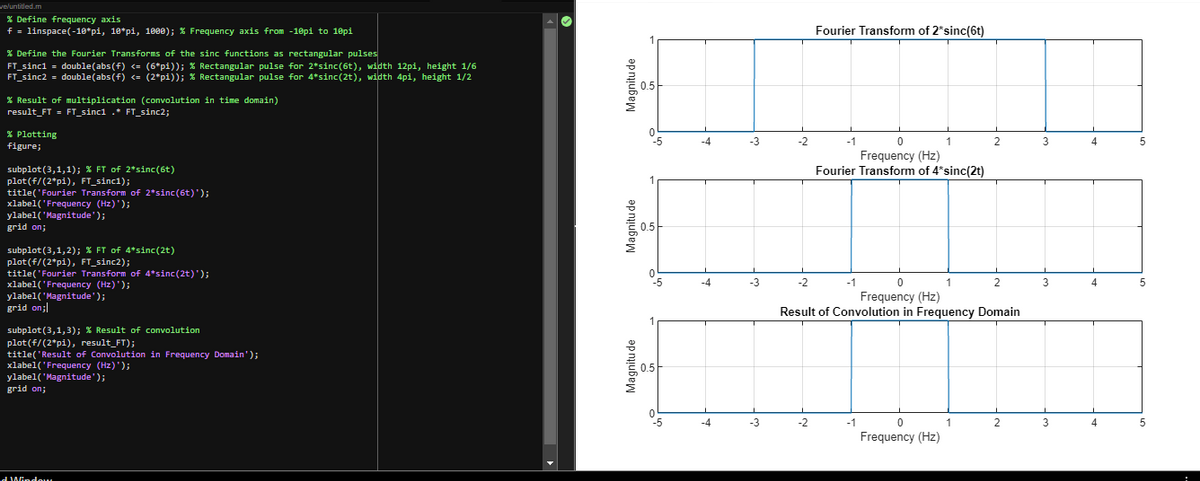Consider the signal x(t) = 2 sinc(6t + 3). the output y (t) = (x *h )(t) when x(t) is passed through a filter with impulse response h (t) = 4sinc(2t -1).
Consider the signal x(t) = 2 sinc(6t + 3). the output y (t) = (x *h )(t) when x(t) is passed through a filter with impulse response h (t) = 4sinc(2t -1).
Introductory Circuit Analysis (13th Edition)
13th Edition
ISBN:9780133923605
Author:Robert L. Boylestad
Publisher:Robert L. Boylestad
Chapter1: Introduction
Section: Chapter Questions
Problem 1P: Visit your local library (at school or home) and describe the extent to which it provides literature...
Related questions
Question
100%
can you explain to me why the convolution of these two sinc fucntions which are rect functions equal a rect function? I thought when you convolute a rectangle and a rectangle with two different lengths, it makes a trapezoid shape. The answer says it is rectangle funtion so my code is corrcect but i dont understand why this is true. I need a step by step solution and explanation.
here is the problem: Consider the signal x(t) = 2 sinc(6t + 3).
the output y (t) = (x *h )(t) when x(t) is
passed through a filter with impulse response h (t) = 4sinc(2t -1). the matlab code was just to help me visuallize

Transcribed Image Text:we/untitled.m
% Define frequency axis
f = linspace(-10*pi, 10*pi, 1000); % Frequency axis from -10pi to 10pi
% Define the Fourier Transforms of the sinc functions as rectangular pulses
FT_sinc1 = double(abs(f) <= (6*pi)); % Rectangular pulse for 2*sinc(6t), width 12pi, height 1/6
FT_sinc2 = double(abs(f) <= (2*pi)); % Rectangular pulse for 4*sinc(2t), width 4pi, height 1/2
% Result of multiplication (convolution in time domain)
result_FT = FT_sinc1 .* FT_sinc2;
% Plotting
figure;
subplot(3,1,1); % FT of 2*sinc(6t)
plot(f/(2*pi), FT_sinc1);
title('Fourier Transform of 2*sinc(6t)');
xlabel('Frequency (Hz)');
ylabel('Magnitude');
grid on;
subplot(3,1,2); % FT of 4*sinc(2t)
plot(f/(2*pi), FT_sinc2);
title('Fourier Transform of 4*sinc(2t)');
xlabel('Frequency (Hz)');
ylabel('Magnitude');
grid on;
subplot(3,1,3); % Result of convolution
plot(f/(2*pi), result_FT);
title('Result of Convolution in Frequency Domain');
xlabel('Frequency (Hz)');
ylabel('Magnitude');
grid on;
d Window.
Magnitude
Magnitude
0.5
Magnitude
0.5
Fourier Transform of 2*sinc(6t)
0
-3
-2
-1
-4
-3
-2
0
Frequency (Hz)
Fourier Transform of 4*sinc(2t)
0
Frequency (Hz)
Result of Convolution in Frequency Domain
2
3
5
2
3
4
5
-5
-3
-2
-1
0
2
3
4
5
Frequency (Hz)
Expert Solution
This question has been solved!
Explore an expertly crafted, step-by-step solution for a thorough understanding of key concepts.
Step by step
Solved in 5 steps with 3 images

Knowledge Booster
Learn more about
Need a deep-dive on the concept behind this application? Look no further. Learn more about this topic, electrical-engineering and related others by exploring similar questions and additional content below.Recommended textbooks for you

Introductory Circuit Analysis (13th Edition)
Electrical Engineering
ISBN:
9780133923605
Author:
Robert L. Boylestad
Publisher:
PEARSON

Delmar's Standard Textbook Of Electricity
Electrical Engineering
ISBN:
9781337900348
Author:
Stephen L. Herman
Publisher:
Cengage Learning

Programmable Logic Controllers
Electrical Engineering
ISBN:
9780073373843
Author:
Frank D. Petruzella
Publisher:
McGraw-Hill Education

Introductory Circuit Analysis (13th Edition)
Electrical Engineering
ISBN:
9780133923605
Author:
Robert L. Boylestad
Publisher:
PEARSON

Delmar's Standard Textbook Of Electricity
Electrical Engineering
ISBN:
9781337900348
Author:
Stephen L. Herman
Publisher:
Cengage Learning

Programmable Logic Controllers
Electrical Engineering
ISBN:
9780073373843
Author:
Frank D. Petruzella
Publisher:
McGraw-Hill Education

Fundamentals of Electric Circuits
Electrical Engineering
ISBN:
9780078028229
Author:
Charles K Alexander, Matthew Sadiku
Publisher:
McGraw-Hill Education

Electric Circuits. (11th Edition)
Electrical Engineering
ISBN:
9780134746968
Author:
James W. Nilsson, Susan Riedel
Publisher:
PEARSON

Engineering Electromagnetics
Electrical Engineering
ISBN:
9780078028151
Author:
Hayt, William H. (william Hart), Jr, BUCK, John A.
Publisher:
Mcgraw-hill Education,